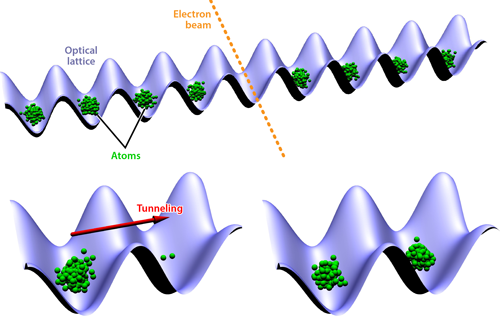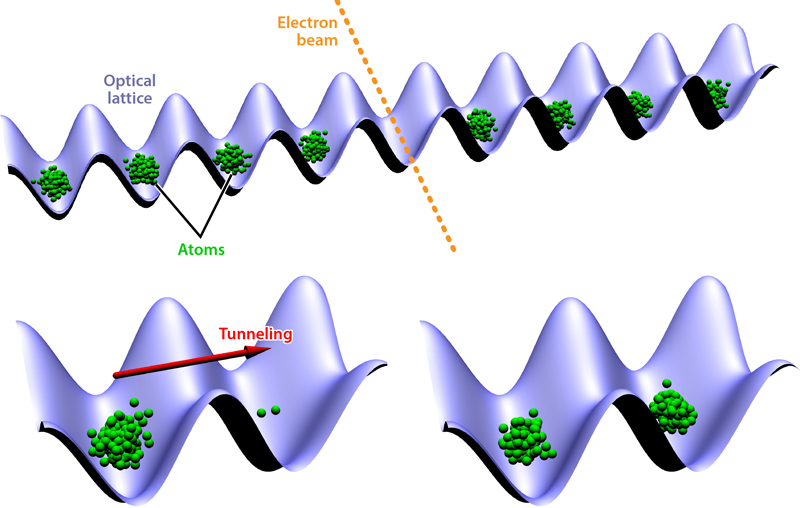Towards an Atomtronic Diode
Atomtronics—an area in which highly controlled atomic gases mimic the properties of electrical circuits [1]—has reached a series of milestones as a result of novel experimental techniques. Being able to tailor the microscopic behavior of these gases opens opportunities to explore fundamental aspects of electronic transport, while also contributing new tools for applications, such as quantum devices for measurement and sensing. Now in a new study, Herwig Ott, from the University of Kaiserslautern in Germany, and colleagues [2] have used techniques in which an atomic gas is prepared and probed with a focused electron beam to realize a system exhibiting a phenomenon known as negative differential conductance. In this phenomenon, the current across a tunnel junction in a circuit decreases as the voltage, or chemical potential difference, is increased. Their experiment demonstrates a building block for complex atomic circuits and opens new avenues for investigating how many-particle transport processes equilibrate to a steady state.
In atomtronics, the circuit components are determined via laser-field or magnetic traps for atoms, which can be designed flexibly. The atoms can be fermionic or bosonic, and their interactions can also be controlled using magnetic fields. This allows for the realization of phenomena beyond classical electronics, such as analogs to spintronics and mesoscopic transport systems. Several such phenomena were recently demonstrated, including the quantized conductance of atoms [3] and thermoelectric transport [4] in quantum wires made with light. Quantized flow of atoms without dissipation of energy has also been observed in a toroidal optical trap with a superfluid gas of bosonic atoms, together with a phenomenon known as hysteresis—which is common in electrical circuits—when a weak barrier is added in the trap [5, 6]. By using laser light to couple the motion of atoms to transitions between different internal atomic states, the spin-Hall effect [7] has also been realized.
Ott and colleagues exploited a major recent experimental development in this field—the possibility of manipulating and probing single microtraps of atoms that are separated by distances of less than a micrometer. This advance has been achieved using optical devices called quantum gas microscopes [8] and also using a focused electron beam [9]. On such short length scales, particles can tunnel quantum mechanically through the barriers between the microtraps formed by laser light on time scales of the order of milliseconds. Ott and co-workers’ system is a one-dimensional periodic arrangement of light called an optical lattice, with each lattice site corresponding to a microtrap that is initially occupied by around 700 bosonic rubidium atoms (Fig. 1, top). The authors used an electron beam to empty one of the lattice’s microtraps. Interactions between atoms lead to a chemical potential difference between the emptied site and the neighboring filled sites. This difference corresponds to a voltage across the barrier (tunnel junction) between the sites. Using the same electron beam, they then probed the atom number as atoms tunnel to repopulate the emptied site (Fig. 1, bottom). These data allowed them to calculate the relationship between the chemical potential difference and the current of atoms flowing across the junction.
The researchers observed the normal increase in current with increasing potential difference when each of these quantities is small—that is, they detected a positive differential conductance. However, when the chemical potential difference was large, they instead detected a negative differential conductance. Such a characteristic is well known in fast semiconductor diodes known as tunnel diodes. In such diodes, negative differential conductance typically occurs as a result of the interplay between the chemical potential on one side of the diode’s junction and the availability of electron holes on the other side of the junction. In Ott and colleagues’ atomic system, however, this behavior occurs because the tunneling rate between sites depends on the atom-number difference. There is a marked decrease in the tunneling rate as the number imbalance becomes large, leading to a decrease in the current as the chemical potential difference is increased.
One of the most interesting aspects of this work is the role of thermalization in the form of “collisional dephasing,” a process that induces a thermal steady state for the current. Ott and co-workers’ setup—a tunnel junction for bosonic atoms—might be expected to exhibit Josephson oscillations [10], which would lead to fluctuations in the atomic density back and forth between the two microtraps. The authors instead observed a steady flow of atoms across the junction until the number of atoms on each site was essentially equal, and the chemical potential difference returned to zero. This can be attributed directly to collisional dephasing: that is, the collisions between atoms induce a thermal steady-state current. This arises because many atoms are involved in the tunneling process, and for each atom that tunnels, there are many available motional modes in the direction transverse to the tunnel junction, which can be populated as a result of collisions between atoms. The population of many modes leads to rapid equilibrium in the system, so that the current is always in a steady state. The high availability of such excited modes allows Ott and colleagues to build a simple model for this mechanism and obtain excellent agreement with their experimental measurements.
How quantum many-particle systems relax to a thermal steady state is a key fundamental question, both in general and, more specifically, in the case of transport systems. This work paves the way for using atomtronic systems to study thermalization under a range of conditions. In particular, it is possible to engineer the processes that cause thermalization or dissipation of energy in these systems, controlling the times on which thermalization occurs. For the present setup, the collisional dephasing could be reduced by working with a smaller initial atom-number imbalance. Future experiments could build on Ott and colleagues’ work by exploring the crossover from Josephson oscillations to the dynamics observed here or by generalizing these studies to other regimes, including quantized conductance. On a more practical level, the demonstration of negative differential conductance can form the basis for building complex, interaction-controlled atomtronic circuits. These could include components such as diodes or amplifiers, which, combined with the controllability and precise measurement techniques available for ultracold atoms, point towards their potential uses in quantum measurement devices.
This research is published in Physical Review Letters.
References
- B. T. Seaman, M. Krämer, D. Z. Anderson, and M. J. Holland, “Atomtronics: Ultracold-Atom Analogs of Electronic Devices,” Phys. Rev. A 75, 023615 (2007).
- R. Labouvie, B. Santra, S. Heun, S. Wimberger, and H. Ott, “Negative Differential Conductivity in an Interacting Quantum Gas,” Phys. Rev. Lett. 115, 050601 (2015).
- S. Krinner, D. Stadler, D. Husmann, J.-P. Brantut, and T. Esslinger, “Observation of Quantized Conductance in Neutral Matter,” Nature 517, 64 (2015).
- J.-P. Brantut, C. Grenier, J. Meineke, D. Stadler, S. Krinner, C. Kollath, T. Esslinger, and A. Georges, “A Thermoelectric Heat Engine with Ultracold Atoms,” Science 342, 713 (2013).
- A. Ramanathan, K. C. Wright, S. R. Muniz, M. Zelan, W. T. Hill III, C. J. Lobb, K. Helmerson, W. D. Phillips, and G. K. Campbell, “Superflow in a Toroidal Bose-Einstein Condensate: An Atom Circuit with a Tunable Weak Link,” Phys. Rev. Lett. 106, 130401 (2011).
- S. Eckel, J. G. Lee, F. Jendrzejewski, N. Murray, C. W. Clark, C. J. Lobb, W. D. Phillips, M. Edwards, and G. K. Campbell, “Hysteresis in a Quantized Superfluid ‘Atomtronic’ Circuit,” Nature 506, 200 (2014).
- M. C. Beeler, R. A. Williams, K. Jiménez-García, L. J. LeBlanc, A. R. Perry, and A. R. Perry, “The Spin Hall Effect in a Quantum Gas,” Nature 498, 201 (2013).
- W. S. Bakr, J. I. Gillen, A. Peng, S. Fölling, and M. Greiner, “A Quantum Gas Microscope for Detecting Single Atoms in a Hubbard-Regime Optical Lattice,” Nature 462, 74 (2009); J. F. Sherson, C. Weitenberg, M. Endres, M. Cheneau, I. Bloch, and S. Kuhr, “Single-Atom-Resolved Fluorescence Imaging of an Atomic Mott Insulator,” 467, 68 (2010).
- T. Gericke, P. Würtz, D. Reitz, T. Langen, and H. Ott, “High-Resolution Scanning Electron Microscopy of an Ultracold Quantum Gas,” Nature Phys. 4, 949 (2008).
- M. Albiez, R. Gati, J. Fölling, S. Hunsmann, M. Cristiani, and M. K. Oberthaler, “Direct Observation of Tunneling and Nonlinear Self-Trapping in a Single Bosonic Josephson Junction,” Phys. Rev. Lett. 95, 010402 (2005).





